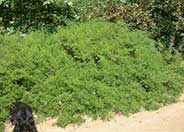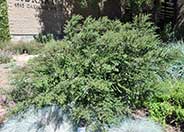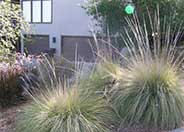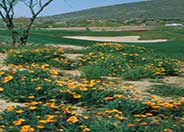
Common name:California Sycamore
Botanical name:Platanus racemosa
The California Sycamore is a fast growing deciduous tree that reaches up to 40'-50' high. It tolerates heat, smog, and drought conditions as well as moist conditions; it is native to riparian areas. It has interesting mottled bark when the tree is bare in winter.

Common name:Centennial Coyote Brush
Botanical name:Baccharis 'Centennial'
This plant is a hybrid that combines a prostrate habit with tolerance for desert conditions. It grows 3' tall and 6' wide. It tolerates heat, sun and frost, maintaining its green appearance.

Common name:Julia Phelps California Lilac
Botanical name:Ceanothus 'Julia Phelps'
Fast-growing and densely branched with small dark green leaves, this is a great bloomer showing a marvelous display of delicate, dark indigo blue flowers found in round clusters of 1". It is extremely drought tolerant, and must not be overwatered. It does best in well-drained soil with little to no summer water. It attracts hummingbirds, butterflies and beneficial insects.

Common name:California Poppy, Golden Poppy
Botanical name:Eschscholzia californica
This small annual (sometimes acts as a perennial) plant will grow to less than 1' tall and has light, small blue green leaves with gold and orange flowers that bloom in spring and summer.

Common name:Cedros Island Verbena
Botanical name:Verbena lilacina 'De La Mina'
Verbena lilacina 'De La Mina' is a selection introduced by the Santa Barbara Botanical Garden. It follows the same wonderful characteristics described under the general species V. lilacina.
Maintenance Tips
Verbena lilacina ‘De La Mina’ is a popular hybrid of the low-growing, herbaceous perennial that is native to a small island off the coast of Baja California. This variety grows 2-6' tall and 3-4' wide with dark purple flowers and a slight fragrance. This is a low-water, low-maintenance plant that rarely requires attention, pruning, or fertilizer. The best way to keep it looking and performing its best is to plant it in a sunny location with well-drained soil and to not overwater in the warmer months. During the fall and winter, the plant usually stops blooming and can sometimes look a little rangy. This is a good time to prune the plant to allow it some dormancy before the growth season begins again in the spring. You can cut back the foliage by one-third of the current size and remove any additional branches that have died back.
Common name:Deer Grass
Botanical name:Muhlenbergia rigens
The Deer Grass is a warm season perennial that forms dense clumps from the base. The spike-like flower stalks grow 3' tall and this grass has striking foundation form. The Deer Grass is native to California and needs watering once or twice a month after it has been established. The more water it has, the greener it is.
Maintenance Tips
Muhlenbergia rigens is a dense grass with a dome-shaped structure arching in all directions. It is commonly referred to as Deergrass. The foliage can reach 3' tall and 5' wide with flower blooms that emerge in the spring and summer 18" above the foliage. This grass requires almost no maintenance if it is planted in its ideal conditions. A sunny location, well-drained soil, and the space to reach its mature size will ensure that it thrives without having to prune for size or shape. It is common to cut back perennial grasses very hard in the winter to prune off the old spent flowers. If you are planning on winter pruning, it is best to wait until you see some new foliage emerge so the newly emerging leaves can cover the cuts quickly.
Common name:Mexican Gold Poppy
Botanical name:Eschscholzia mexicana
Mexican Gold Poppy is similar to the California Poppy, but smaller. It has upward-facing, four petaled orange blooms. It grows to 8" high. It is considered drought tolerant but extra summer water will extend the flowering season.

Common name:Coast Sunflower, Coast Encelia
Botanical name:Encelia californica
Encelia californica is a fast growing woody subshrub with bright green foliage and yellow daisy-type flowers. It can be used effectively in the natural landscape with regular pruning to maintain form. It is more commonly used in native restoration work. In inland situations, it requires more regular water. It grows to 4' tall and wide.
Maintenance Tips
Encelia californica is a California native shrub that grows quickly up to 4' wide. It will look and perform its best when planted in full sun in well-drained soil with enough space to reach its mature size. It is very drought tolerant once established and rarely has any pest or disease issues. This shrub has lots of cross-branching and can grow very dense in just one growing season. Pruning throughout the growing season is discouraged as it will affect the amount of blooms that emerge. This is the type of shrub that can resemble a tumbleweed when the blooming cycle ends. Cutting it back hard in the early fall will remove many of the woody branches and will encourage new growth to occur. There is no need to fertilize as the plant will perform very well without supplemental nutrients in almost all soil conditions.Designer: Bill Butler
Photographer: GardenSoft